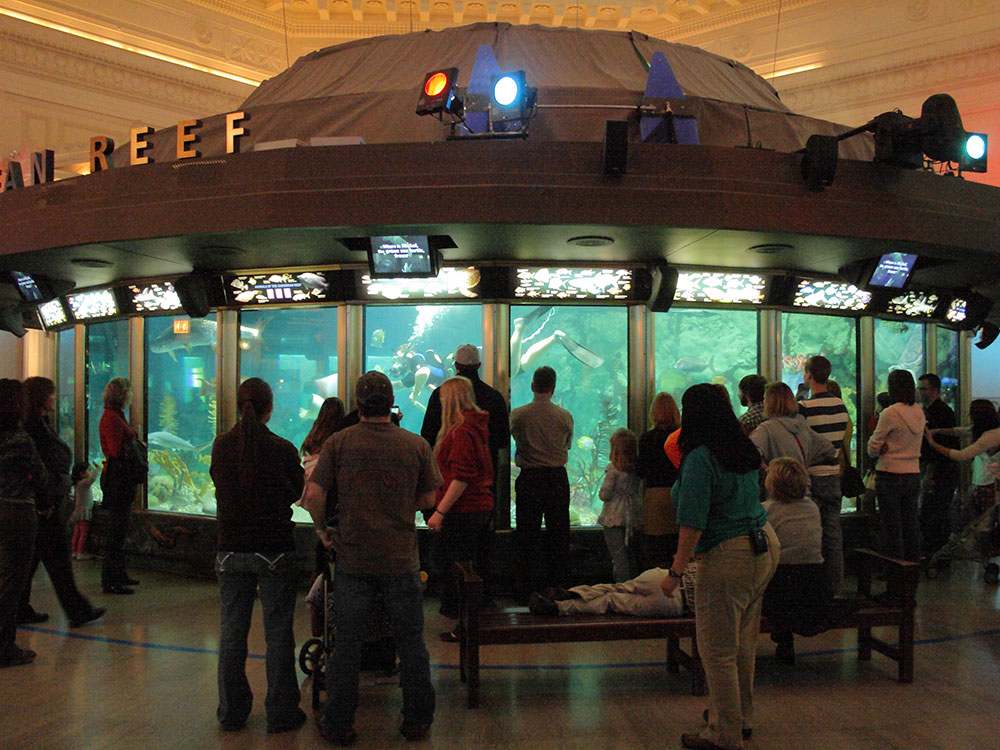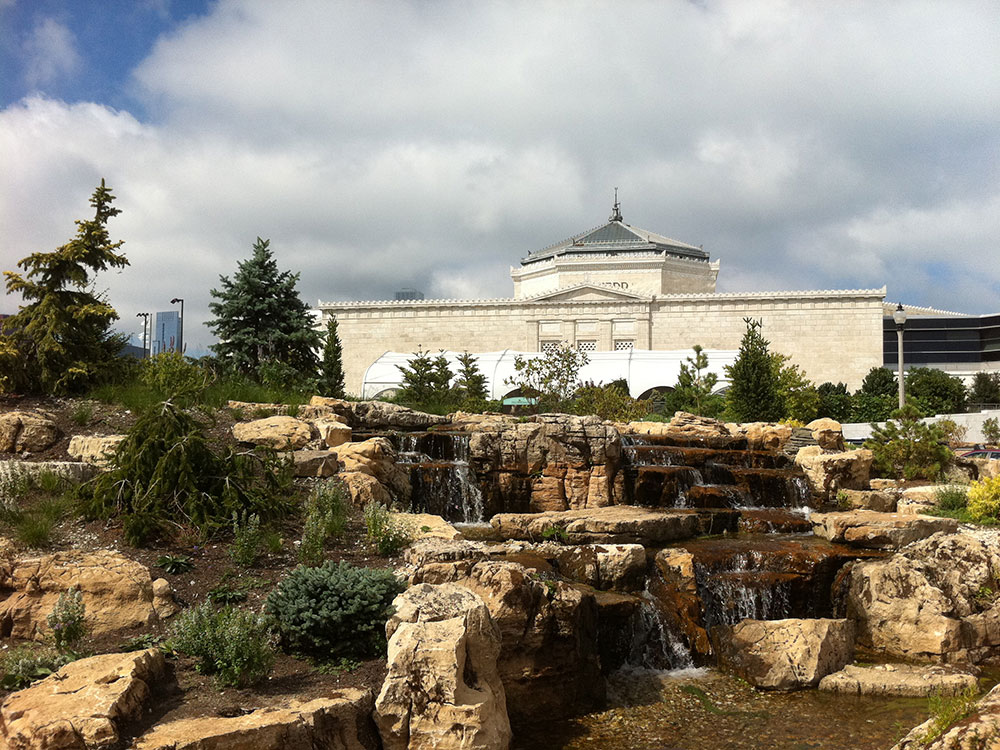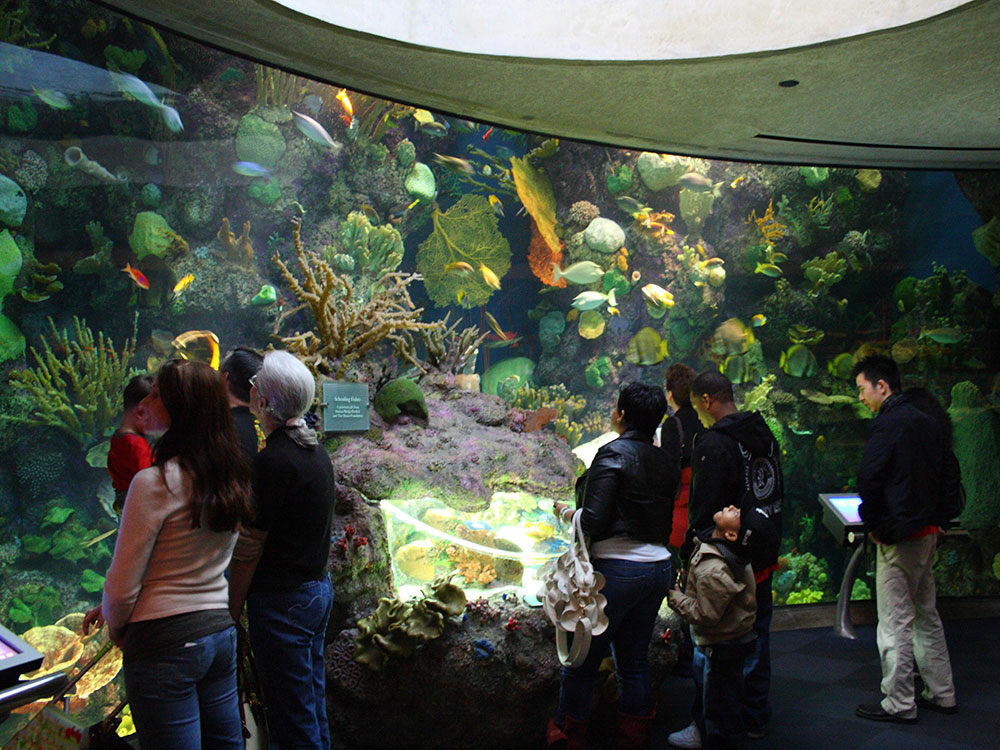Indoor public aquarium with its 5 million US gal aquarium was for some time the largest indoor facility in the world and today it holds about 32,000 animals
General Information
How to Get There
Overview
Shedd Aquarium (formally the John G. Shedd Aquarium) is an indoor public aquarium in Chicago, Illinois. Opened on May 30, 1930, the 5 million US gal (19,000,000 l; 4,200,000 imp gal) aquarium was for some time the largest indoor facility in the world. Today it holds about 32,000 animals.
Shedd Aquarium was the first inland aquarium with a permanent saltwater fish collection. It is located on Lake Michigan, on the Museum Campus Chicago, along with the Adler Planetarium and the Field Museum of Natural History.
The aquarium contains 1,500 species, including fish, marine mammals, birds, snakes, amphibians, and insects. It was designated a National Historic Landmark in 1987.
Shedd Aquarium was the gift of retail leader John G. Shedd, a protégé of Marshall Field (benefactor of the adjacent Field Museum), to the city of Chicago. Although Shedd only lived long enough to see the architect's first drawings for the aquarium, his widow, Mary R. Shedd, cut the ribbon at the official opening ceremony.
In 1971, Shedd Aquarium added one of its most popular exhibits, a 90,000-US-gallon (340,000 l) exhibit reproducing a Caribbean coral reef.
There are several permanent exhibits at Shedd: Waters of the World, Caribbean Reef, Amazon Rising, Wild Reef, and the Abbott Oceanarium.
The oldest galleries in the aquarium feature exhibits on oceans, rivers, islands and lakes, and Chicago's own local waters. Species on exhibit include Haraldmeier's mantella, a giant Pacific octopus, Gymnarchus, blue iguana, starfish, seahorses, and alligator snapping turtle.
The Caribbean Reef exhibit was built in 1971, on the site of the aquarium's very first exhibit, the Tropical Pool. A feature of this exhibit is a diver that interacts with the animals while talking with the people. A part of the exhibit is a 90,000-US-gallon (340,000 l) circular tank that allows for maximum walk-around viewing. It was one of the first habitats to display schooling fish. It is also home to the rescued green sea turtle, Nickel, as well as bonnethead sharks, Tarpons, stingrays, and many more. The exhibit is near the center of the first floor. It is adjacent to Amazon Rising, Waters of the World, and Wild Reef.
The Amazon Rising exhibit is a 8,600-square-foot (800 m2) walkthrough flooded forest recreation of the Amazon River and the surrounding jungle. This exhibit contains 250 different species, and its highest water level is 6 feet (1.8 m). Species from this area on exhibit include Green anacondas, Red bellied piranhas, electric eels, freshwater stingrays, Dwarf caimans, Caiman lizards, wattled jacanas, yellow-spotted river turtles, red-footed tortoises, Yellow-footed tortoises, Mata matas, Arowanas, different species of South American birds, fish, and frogs, and many more.
In 2003 Shedd opened Wild Reef, a permanent exhibit located two levels below the main building. The exhibit contains a total of 525,000 US gallons (1,990,000 l) and recreates a Philippine coral reef on the Apo Island marine reserve, complete with living coral, multiple species of fish and rays, and a collection of sharks such as sandbar, zebra, blacktip reef sharks, guitar fish, and even Spotted wobbegongs. The main draw of this attraction is a 400,000-US-gallon (1,500,000 l) shark tank with 12-foot (3.7 m) high curved windows, allowing visitors a diver's-eye view. The Wild Reef exhibit also features a saltwater tank display area where coral is propagated and grown for conservation purposes.
The exhibit contains an underwater viewing area of the beluga whales, the Pacific white-sided dolphins and the Sea otters, Rockhopper penguins, Magellanic penguins, 5 circular tanks for Aurelia aurita/moon jellyfish, shrimp, seahorses, and starfish that are by an interactive submarine model. There is also a starfish touch pool.
Opened on May 17, 2013, this exhibit allows guests to touch cownose rays and yellow spotted rays as they swim around their 20,000 US gallons (76,000 l) outdoor exhibit. Located on the aquarium's South Terrace, this exhibit is open seasonally from May through October (weather permitting).
In 1991, Shedd Aquarium opened the Oceanarium (known since 2010 as the Abbott Oceanarium), a large addition to the aquarium that features marine mammals, including Pacific white-sided dolphins, beluga whales, sea otters and California sea lions, as well as Rockhopper penguins, and Magellanic penguins that are located in the Polar Play Zone, on the right side of the stairway that's next to the sealions is an open estuary tank for several cuttlefish and by the sea otter exhibit, is a large natural looking touch tank for tide pool creatures like crabs, sea cucumbers and sea anemones. The Polar Play Zone is an interactive play area for children as well as the home to the Magellanic and Rockhopper penguins. The lower level of the Oceanarium allows underwater viewing of the beluga whales and the dolphins. It holds 3 million US gallons (11,000,000 l) in total; the largest single tank is the 2-million-US-gallon (7,600,000 l) "Whale Harbour". The Oceanarium is the largest indoor marine mammal facility in the world.
One World aquatic presentation also called land and water, replaced Fantasea in 2013. The show can feature Pacific white-sided dolphins, Beluga whales, Magellanic Penguins, Rockhopper penguins, California sea lions, a Barred owl, a Dogo Argentino mix, a green tree python, two Red-and-green macaws, Red-tailed hawks, a Great horned owl and other Shedd Aquarium animals.
Shedd Aquarium is also notable for its architecture. The basic design, by architectural firm Graham, Anderson, Probst & White, is taken from classical Greek architecture, more specifically Beaux Arts, to match the other structures of the Museum Campus. The central aquarium building is octagonal, fronted by Doric columns and a formal staircase and topped by a dome. Aquatic motifs are worked in at every opportunity; tortoise shells, dolphins, octopuses, waves, and even the Trident of Poseidon can be found all over the aquarium's exterior and interior. Improving upon its predecessor inland aquarium, the Belle Isle Aquarium in Detroit, extensive use was made of designs by Mary Chase Perry Stratton, incorporating her custom-made Pewabic Pottery tile. The Oceanarium is done in a more modern style representing the Pacific Northwest, but one that blends with the older part of the building. "Whale Harbor", the Oceanarium's 2-million-US-gallon (7,600,000 l) main tank, is backed by a wall of windows that look out onto Lake Michigan.
This article uses material from the Wikipedia article "Shedd Aquarium", which is released under the Creative Commons Attribution-Share-Alike License 3.0
-1000.jpg)


